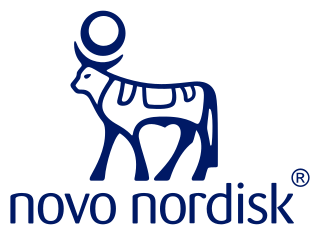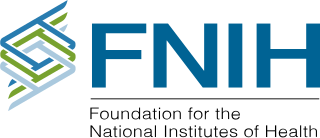
The Wellcome Trust is a charitable foundation focused on health research based in London, United Kingdom. It was established in 1936 with legacies from the pharmaceutical magnate Henry Wellcome to fund research to improve human and animal health. The aim of the Trust is to "support science to solve the urgent health challenges facing everyone." It had a financial endowment of £29.1 billion in 2020, making it the fourth wealthiest charitable foundation in the world. In 2012, the Wellcome Trust was described by the Financial Times as the United Kingdom's largest provider of non-governmental funding for scientific research, and one of the largest providers in the world. According to their annual report, the Wellcome Trust spent GBP £1.1 billion on charitable activities across their 2019/2020 financial year. According to the OECD, the Wellcome Trust's financing for 2019 development increased by 22% to US$327 million.

Novo Nordisk A/S is a Danish multinational pharmaceutical company headquartered in Bagsværd with production facilities in nine countries and affiliates or offices in five countries. Novo Nordisk is controlled by majority shareholder Novo Holdings A/S which holds approximately 28% of its shares and a majority (77%) of its voting shares.
Toxicogenomics is a subdiscipline of pharmacology that deals with the collection, interpretation, and storage of information about gene and protein activity within a particular cell or tissue of an organism in response to exposure to toxic substances. Toxicogenomics combines toxicology with genomics or other high-throughput molecular profiling technologies such as transcriptomics, proteomics and metabolomics. Toxicogenomics endeavors to elucidate the molecular mechanisms evolved in the expression of toxicity, and to derive molecular expression patterns that predict toxicity or the genetic susceptibility to it.
C.H. Boehringer Sohn AG & Co. KG is the parent company of the Boehringer Ingelheim group, which was founded in 1885 by Albert Boehringer (1861–1939) in Ingelheim am Rhein, Germany. As of 2018, Boehringer Ingelheim is one of the world's largest pharmaceutical companies, and the largest private one. Headquartered in Ingelheim, it operates globally with 146 affiliates and more than 47,700 employees. Unlike most large pharmaceutical companies which are listed, the company is private and fully owned by the Boehringer, Liebrecht and von Baumbach families. The company's key areas of interest are: respiratory diseases, metabolism, immunology, oncology and diseases of the central nervous system. Boehringer Ingelheim is a full member of the European Federation of Pharmaceutical Industries and Associations (EFPIA). The corporate logo of Boehringer Ingelheim depicts a stylized rendition of the central section of the imperial palace of Charlemagne.

Drug development is the process of bringing a new pharmaceutical drug to the market once a lead compound has been identified through the process of drug discovery. It includes preclinical research on microorganisms and animals, filing for regulatory status, such as via the United States Food and Drug Administration for an investigational new drug to initiate clinical trials on humans, and may include the step of obtaining regulatory approval with a new drug application to market the drug. The entire process—from concept through preclinical testing in the laboratory to clinical trial development, including Phase I–III trials—to approved vaccine or drug typically takes more than a decade.

Servier Laboratories is an international pharmaceutical company governed by a non-profit foundation, with its headquarters in France (Suresnes).

The European Federation of Pharmaceutical Industries and Associations (EFPIA) is a Brussels-based trade association and lobbying organisation, founded in 1978 and representing the pharmaceutical industry operating in Europe. Through its membership of 36 national associations and 39 leading pharmaceutical companies, the EFPIA represents 1,900 European companies.

Merck Serono is a pharmaceutical company headquartered in Darmstadt, Germany, and a brand and division of Merck focused on biopharmaceuticals.

Johnson & Johnson Pharmaceutical Research and Development (J&JPRD) is a subsidiary of Johnson & Johnson that is responsible for discovering and developing pharmaceutical drugs. J&JPRD has research sites located in Raritan, New Jersey, Titusville, New Jersey, Spring House, Pennsylvania, La Jolla, California, Beerse, Belgium and Toledo, Spain.

Giulio Superti-Furga is an Italian molecular and systems biologist based in Vienna, Austria. He is the Scientific Director of CeMM Research Center for Molecular Medicine of the Austrian Academy of Sciences, and Professor of Medical Systems Biology at the Medical University of Vienna. In January 2024, he was appointed Chair of EU-LIFE, the alliance of research institutes advocating for excellent research in Europe.
An imaging biomarker is a biologic feature, or biomarker detectable in an image. In medicine, an imaging biomarker is a feature of an image relevant to a patient's diagnosis. For example, a number of biomarkers are frequently used to determine risk of lung cancer. First, a simple lesion in the lung detected by X-ray, CT, or MRI can lead to the suspicion of a neoplasm. The lesion itself serves as a biomarker, but the minute details of the lesion serve as biomarkers as well, and can collectively be used to assess the risk of neoplasm. Some of the imaging biomarkers used in lung nodule assessment include size, spiculation, calcification, cavitation, location within the lung, rate of growth, and rate of metabolism. Each piece of information from the image represents a probability. Spiculation increases the probability of the lesion being cancer. A slow rate of growth indicates benignity. These variables can be added to the patient's history, physical exam, laboratory tests, and pathology to reach a proposed diagnosis. Imaging biomarkers can be measured using several techniques, such as CT, electroencephalography, magnetoencephalography, and MRI.
Critical Path Institute (C-Path) is a non-profit organization created to improve the drug development process; its consortia include more than 1,600 scientists from government regulatory and research agencies, academia, patient organizations, and bio-pharmaceutical companies.
In silico medicine is the application of in silico research to problems involving health and medicine. It is the direct use of computer simulation in the diagnosis, treatment, or prevention of a disease. More specifically, in silico medicine is characterized by modeling, simulation, and visualization of biological and medical processes in computers with the goal of simulating real biological processes in a virtual environment.

The Foundation for the National Institutes of Health (FNIH) is a not-for-profit, 501(c)(3) charitable organization established by the US Congress in 1990. Located in North Bethesda, MD, the FNIH raises private-sector funds, and creates and manages alliances with public and private institutions in support of the mission of the National Institutes of Health (NIH).
Open PHACTS was a European initiative public–private partnership between academia, publishers, enterprises, pharmaceutical companies and other organisations working to enable better, cheaper and faster drug discovery. It has been funded by the Innovative Medicines Initiative, selected as part of three projects to "design methods for common standards and sharing of data for more efficient drug development and patient treatment in the future".

eTOX is a temporary consortium established in 2010 to share and use toxicology data. It is a pre-competitive collaboration which main goal is to create and distribute tools to predict drug side-effects based on pre-clinical experiments. Aims are a better in silico predictability of potential adverse events and a decrease of the use of animals in toxicological research. eTOX is funded by the Innovative Medicines Initiative (IMI).

Michel Goldman is a Belgian medical doctor who specialized in internal medicine and immunology.

The Faculty of Pharmacy, Universidade de Lisboa (FFUL) is a Portuguese public institution of higher education dedicated to education, research, knowledge transfer and continuing education in the fields of pharmacy, medicine, and pharmaceutical sciences.
The European Lead Factory is a public-private partnership that aims to accelerate early drug discovery in Europe. The European Lead Factory is funded by the Innovative Medicines Initiative and consists of a pan-European consortium that includes 7 pharmaceutical companies as well as partners from academia and small and medium-sized enterprises (SMEs).
Annette Therese Byrne is an Irish physiologist, Professor and Head of the Royal College of Surgeons in Ireland (RCSI) Precision Cancer Medicine group. Her research considers metastatic colorectal cancer and glioblastoma.












